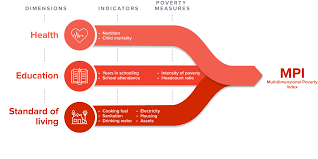Multidimensional Poverty Index 2023 | 12 Jul 2023
For Prelims: Multidimensional Poverty Index, UNDP, Poverty, Education, Health, Standard of Living.
For Mains: Multidimensional Poverty Index.
Why in News?
Recently, the Global Multidimensional Poverty Index (MPI) 2023 has been released by the United Nations Development Programme (UNDP) and the Oxford Poverty and Human Development Initiative (OPHI).
- The MPI measures “interlinked deprivations in health, education and standard of living that directly affect a person’s life and wellbeing”.
What are the Key Highlights of the Index?
- Global Outlook:
- Globally, 1.1 billion people (18% of the total population) out of 6.1 billion people, are acutely multidimensionally poor and live in acute multidimensional poverty across 110 countries.
- Sub-Saharan Africa has 534 million poor and South Asia has 389 million.
- These two regions are home to approximately five out of every six poor people.
- Children under 18 years old account for half of MPI-poor people (566 million).
- The poverty rate among children is 27.7%, while among adults it is 13.4 %.
- Outlook for India:
- Poverty in India: India still has more than 230 million people who are poor.
- The UNDP defines, “Vulnerability — the share of people who are not poor but have deprivations in 20 - 33.3% of all weighted indicators — can be much higher.
- India has some 18.7% population under this category.
- India’s Progress in Poverty Reduction: India is among 25 countries, including Cambodia, China, Congo, Honduras, Indonesia, Morocco, Serbia, and Vietnam, that successfully halved their global MPI values within 15 years.
- Some 415 million Indians escaped poverty between 2005-06 and 2019-21.
- The incidence of poverty in India declined significantly, from 55.1% in 2005/2006 to 16.4% in 2019/2021.
- In 2005/2006, approximately 645 million people in India experienced multidimensional poverty, a number that decreased to about 370 million in 2015/2016 and further to 230 million in 2019/2021.
- Improvement in Deprivation Indicators: India progressed significantly in all the three deprivation indicators: Health, Education, Standard of living.
- Decline in poverty has been equal as well, cutting across regions and socio-economic groups.
- The poorest states and groups, including children and people in disadvantaged caste groups, had the fastest absolute progress.
- The percentage of people who were multidimensionally poor and deprived of nutrition decreased from 44.3% in 2005/2006 to 11.8% in 2019/2021, and child mortality fell from 4.5% to 1.5%.
- Decline in poverty has been equal as well, cutting across regions and socio-economic groups.
- Poverty in India: India still has more than 230 million people who are poor.
What are the Recommendations?
- There is a need for context-specific multidimensional poverty indices that reflect national definitions of poverty.
- While the global MPI provides a standardized methodology, national definitions offer a comprehensive understanding of poverty specific to each country.
- It is crucial to consider these context-specific indices to evaluate and address poverty effectively.
What is the Global Multidimensional Poverty Index?
- About:
- The index is a key international resource that measures acute multidimensional poverty across more than 100 developing countries.
- It was first launched in 2010 by the OPHI and the Human Development Report Office of the UNDP.
- The MPI monitors deprivations in 10 indicators spanning health, education and standard of living and includes both incidence as well as intensity of poverty.
- MPI Indicators and Dimensions:

- A person is multidimensionally poor if she/he is deprived in one third or more (means 33% or more) of the weighted indicators (out of the ten indicators). Those who are deprived in one half or more of the weighted indicators are considered living in extreme multidimensional poverty.
UPSC Civil Services Examination Previous Year Question (PYQ)
Prelims
Q. The Multi-dimensional Poverty Index developed by Oxford Poverty and Human Development Initiative with UNDP support covers which of the following? (2012)
- Deprivation of education, health, assets and services at household level
- Purchasing power parity at national level
- Extent of budget deficit and GDP growth rate at national level
Select the correct answer using the codes given below:
(a) 1 only
(b) 2 and 3 only
(c) 1 and 3 only
(d) 1, 2 and 3
Ans: (a)
Mains
Q. Despite Consistent experience of high growth, India still goes with the lowest indicators of human development. Examine the issues that make balanced and inclusive development elusive. (2016)
